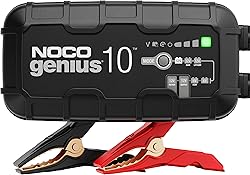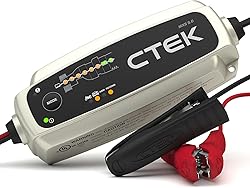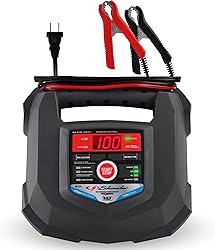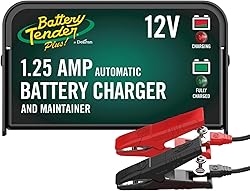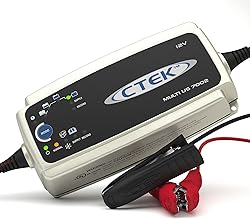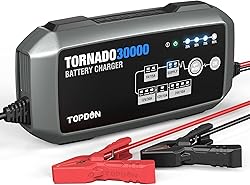Whether your car has been sitting for a while or just struggles to start on those chilly mornings, having the best car battery charger in your garage can go from nice-to-have to absolutely essential. I’ve been there more times than I care to admit: late for work, hood up, waiting for a jump that never comes. That’s why I started testing chargers myself to find the ones that actually work and are worth your money. To cover all bases, I recommend a solid charger for home and one of the top rated jump starters for the road—only the best ones are worth trusting when your battery quits.
Over the past few months, I’ve run a handful of these chargers through the wringer—reviving dead batteries, maintaining charges on seasonal vehicles, even tossing one in the trunk for emergencies. Some made me question how I ever got by without them, while others… well, let’s just say they’re collecting dust now. If you’re looking for a dependable charger that won’t leave you stranded, keep reading. This roundup will save you time, money, and possibly a tow truck call.
Best Car Battery Chargers in 2025
| Image | Model | |
|---|---|---|
 | Best Smart Charger For Reviving Dead Batteries NOCO Genius10 ChargerEditor's Choice Check Price | Check Price |
 | Best Charger For Cold Weather And Battery Recovery CTEK MXS 5.0Check Price | Check Price |
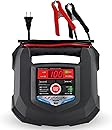 | Best Automatic Charger For Versatile Battery Types Schumacher SC1280Check Price | Check Price |
 | Best Compact Charger For Lead-Acid And Lithium Batteries NOCO Genius1Check Price | Check Price |
 | Best Smart Charger For Long-Term Battery Maintenance Battery Tender PlusCheck Price | Check Price |
 | Best Smart Charger For All-Weather Battery Maintenance CTEK US 7002Check Price | Check Price |
 | Best High-Output Charger For Diagnostics And ECU Work TOPDON Tornado30000Check Price | Check Price |
1. NOCO Genius10 Smart Battery Charger
Sometimes, a dead battery feels like the start of a frustrating day — or at least a hefty bill. But the NOCO Genius10 has flipped that narrative for me. It’s impressively compact, yet somehow delivers even more power than its predecessor. I’ve had batteries that were so far gone, I thought the recycling center was the only option, but this smart little unit brought them back to life without breaking a sweat.
Where it really stands out is in its flexibility and safety. Whether I’m charging a lead-acid battery on the John Deere or maintaining a lithium-ion unit over the winter, it handles it all. Force Mode deserves a special mention here — manually bringing dead batteries back from zero volts is a serious feat. And the ability to leave it connected indefinitely without worrying about overcharging? That’s the kind of stress-free maintenance I can get behind. The only speed bump? The instructions could be a bit more user-friendly, but once you’re familiar with the modes, it’s smooth sailing.
Pros:
- Effectively revives deeply discharged and neglected batteries
- Works on both lead-acid and lithium-ion types
- Compact but powerful design with smart temperature compensation
- Can stay connected indefinitely for worry-free maintenance
Cons:
- Instructions could be clearer and more intuitive
- Charging can take a while for heavily drained batteries
2. CTEK MXS 5.0 Smart Battery Maintainer
I’ve gone through my fair share of battery chargers, but the CTEK MXS 5.0 feels like that multi-tool you never realized you needed — until your battery dies in the middle of winter. What impressed me most is how thoughtful the design is. It’s not just a charger; it’s a battery whisperer. It brought back to life a week-dead battery on my rarely used BMW with surprising ease, even in frigid temperatures, and didn’t flinch while doing it. The 8-step smart charging makes the whole process brainless — just connect, select, and walk away.
One of my favorite aspects of this unit is the reconditioning function. I’ve used it on multiple older batteries that I was ready to toss — a few overnight sessions later, they were back to holding a solid charge. There’s also a gratifying level of confidence this tool inspires because it’s spark-proof, weather-sealed, and has built-in polarity protection. I also appreciate that I didn’t have to remove my battery for it to work — just hook it up and let it do its thing.
Pros:
- Excellent for cold weather and long-term storage use
- Reconditioning feature revives weak batteries efficiently
- Safe, spark-proof, and intuitive to operate
- Compact but packed with smart features
Cons:
- Proprietary connectors limit compatibility with other charger accessories
- Very faint buzzing sound during use
3. Schumacher SC1280 Automatic Charger
The Schumacher SC1280 has proven to be a pleasant surprise in the battery charging world. I like simplicity when it comes to charging — connect it, let it do its thing, and know that I won’t be babysitting my battery throughout the process. This unit does exactly that. With automatic voltage detection and a microprocessor-controlled charging process, it’s smart enough to know what your battery needs and when it’s done. Plus, that 15-amp rapid charging mode really saves time when you’re dealing with a larger battery.
I’ve used it on everything from my car to my old lawn tractor battery without missing a beat. The digital display and push-button interface make things clear and easy, and I appreciate the built-in safety features like reverse polarity protection. Just hook up the clamps — which are color-coded, by the way — and the charger handles the rest. It won’t win any beauty contests, but for the price, it’s hard to beat what this thing offers on functionality alone.
Pros:
- Fully automatic with smart voltage detection
- Fast 15A charging for cars and trucks
- 3A mode for smaller batteries like motorcycles or lawn equipment
- Clear digital display and easy controls
Cons:
- Not the most compact unit for tight storage spaces
4. NOCO Genius1 Smart Battery Charger
The NOCO Genius1 might just be the little charger that could. I’ve used compact trickle chargers before, but this one punches way above its weight. It’s not much larger than your average smartphone, but it’s incredibly capable—whether you’re reviving a deeply discharged car battery or maintaining a motorcycle or lawn mower that’s been sitting idle for months.
What impressed me the most was its “set it and forget it” nature. Once hooked up, this charger doesn’t need babysitting. It adjusts automatically for temperature shifts and can even coax life back into batteries that most would consider dead weight. Charging a battery from zero isn’t instant—patience is definitely required—but when you’re not in a rush, it’s a lifesaver. Just know this isn’t a jump starter; it’s more like a battery defibrillator with a library voice—quiet, steady, and dependable.
If you’re into simplicity and reliability over flashy displays, the Genius1 is a no-brainer. It’s ideal for weekend mechanics or anyone with a vehicle that hibernates half the year. Easy on the wallet, and easy on the brain once you’re past the initial learning curve.
Pros:
- Compact size but surprisingly powerful for 1A charging
- Restores deeply discharged batteries—even near zero volts
- Safe for long-term battery maintenance
- Supports both 6V and 12V lead-acid and lithium batteries
Cons:
- Instructions could be more user-friendly
- Slow charging speed requires patience—definitely not for quick boosts
5. Battery Tender Plus 12V Smart Charger
I’ve had my fair share of battery chargers—some smart, some not so much—and the Battery Tender Plus stands out as one of the most thoughtfully engineered of the bunch. It takes the stress out of battery maintenance, especially for those of us with toys that sit dormant during colder months. Whether it’s a motorcycle or a lawn mower, it does exactly what it’s supposed to do without any drama.
What really drew me in was the four-step charging and maintaining process. It’s not just a one-dimensional trickle charger; it adapts and reads the battery’s needs. That’s a big deal when you’re trying to extend the life of an expensive AGM or standard lead-acid battery. I also appreciated the quick-disconnect harness, which made it super easy to hook up without fumbling around under the hood or seat every time. Honestly, it’s plug-and-forget in the best way.
Pros:
- Adaptive smart charging extends battery life
- Safe 4-step charging process ensures optimal battery health
- Quick-disconnect harness makes setup painless
- Solid build with a generous 10-year warranty
Cons:
- Only supports 12V systems—no versatility for 6V
- Not the cheapest option on the market
6. CTEK Multi US 7002 Smart Charger
If you’re like me and you’ve got a garage full of 12V batteries—from your daily driver to a weekend-warrior ride or even lawn equipment that sits for months—you know the value of a charger that can do more than just push electrons. That’s what first drew me to the CTEK Multi US 7002. This thing isn’t your standard old-school battery charger. It’s smart, deliberate, and almost freakishly gentle with your battery’s health.
What really makes it stand out is how confidently it handles both traditional flooded batteries and modern AGM types. I hooked it up to an older AGM battery that had been sitting far too long, and after a full charge cycle and some time in the reconditioning mode, the battery came back to life like it had a second lease on life. No dramatic heat-ups. No fried electronics. And thanks to the built-in supply mode, I was even able to swap out a dead battery without losing my car’s stored settings. Real lifesaver there.
Also worth noting—the CTEK doesn’t just charge, it meticulously goes through a multi-step process that ensures your battery gets what it needs without being overfed. That kind of caution matters if you care about getting the full life out of your investment, whether it’s a $50 mower battery or something ten times that.
Pros:
- Handles standard and AGM batteries with ease
- Reconditioning and desulfation modes can revive older or neglected batteries
- Supply mode lets you maintain power while swapping batteries
- Extremely safe for electronic systems—no need to disconnect the battery
Cons:
- Not designed for emergency jump-starts
7. TOPDON Tornado30000 High-Amp Charger
I picked this beast up when I needed something serious for maintaining power during ECM programming sessions and lengthy diagnostic tasks. The first thing I noticed? This isn’t your average trickle charger—it’s a fully capable 30-amp power station with enough versatility to juice just about any battery you throw at it, from 6V to 24V, lead-acid to lithium.
In my garage setup, it proved its worth quickly. I used the SUPPLY mode to keep my vehicle online during long coding sessions, and it didn’t flinch. Voltage stayed rock-solid, right where I needed it—crucial when flashing modules that don’t exactly play nice with voltage drops. It’s got 12 charging modes to work with pretty much every scenario—from frigid winters to sulfated, forgotten batteries. That said, it is a bit bulky, and I do wish it came with a carrying case or some tidy way to manage the cables. Still, the tradeoff for that muscle and functionality is well worth the garage space.
Pros:
- Delivers stable, high-amperage power—ideal for programming and diagnostics
- Works with nearly all battery types and voltages
- Effective repair/desulfation modes for recovery
- Long cables make positioning easy in a shop environment
Cons:
- No storage case or organizer for the cables
- Can be picky in long-term charging if you’re not closely monitoring
What to Look for When Buying a Car Battery Charger
Amperage Output: Don’t Go Overboard
Here’s where most people mess up — they think bigger is always better. For most cars, a 10-amp charger is the sweet spot, giving you a good balance between charging speed and battery health. I’ve seen too many customers fry their batteries with those 50-amp “quick charge” monsters because they got impatient. Trust me, slow and steady wins the race here.
If you’re dealing with larger vehicles like trucks or RVs, then yeah, you might need something in the 15-20 amp range. But for your average sedan or SUV? Stick with 6-10 amps for regular maintenance charging. Your battery will thank you by lasting longer, and you won’t risk cooking the internal plates.
Smart vs. Manual Chargers
Look, I get it — manual chargers are cheaper and seem simpler. But after pulling countless overcharged batteries out of cars (don’t ask how I know), I’m telling you to spring for a smart charger. These units automatically adjust their output and shut off when the battery is full, which means you can literally set it and forget it without turning your battery into an expensive paperweight.
Smart chargers also do something called “maintenance mode” or “float charging,” where they keep your battery topped off without overcharging. This is pure gold if you’ve got a classic car, motorcycle, or anything that sits for months at a time.
Battery Type Compatibility
Not all batteries are created equal, and your charger needs to know the difference. Make sure your charger can handle whatever type of battery you’ve got — whether it’s a traditional lead-acid, AGM, gel cell, or one of those fancy lithium setups. Most modern chargers are pretty universal, but some older or budget models might not play nice with AGM batteries.
I learned this the hard way when a customer brought in his BMW with a dead AGM battery. Used the wrong charging profile and damaged the battery’s internal structure. AGM batteries need a specific voltage curve, so don’t cheap out on a charger that doesn’t recognize different battery types.
Essential Features You Actually Need
Reverse polarity protection is non-negotiable — period. I’ve seen what happens when someone hooks up the cables backwards, and it’s not pretty. Sparks, smoke, and a very expensive lesson in basic electrical safety. Any charger worth buying should shut down immediately if you mix up the connections.
Also look for these must-haves:
- Temperature compensation (adjusts charging based on ambient temperature)
- Short circuit protection
- Spark-proof connections
- Clear LED indicators showing charging status
Portable vs. Bench Chargers
This really comes down to how you plan to use it. Portable units are great for roadside emergencies or if you’re working on cars in different locations. They’re usually lighter and more compact, but they sacrifice some power and features for portability.
Bench chargers are the workhorses — more power, better cooling, and usually more charging modes. If you’ve got a dedicated garage space and mostly work on cars at home, go with a bench unit. They’re built to last and handle heavy use without overheating.
Build Quality and Warranty
I’ve tested chargers that looked identical on paper but performed completely differently in the real world. Heavy-duty cables, solid clamps that actually grip the terminals, and a housing that won’t crack when you accidentally drop it — these details matter more than you’d think.
Don’t ignore the warranty either. A company that stands behind their product with a decent warranty (at least 2-3 years) is usually confident they’ve built something that won’t fail after six months of use. I’ve got chargers in my shop that are pushing 15 years old and still working perfectly because I bought quality from the start.

